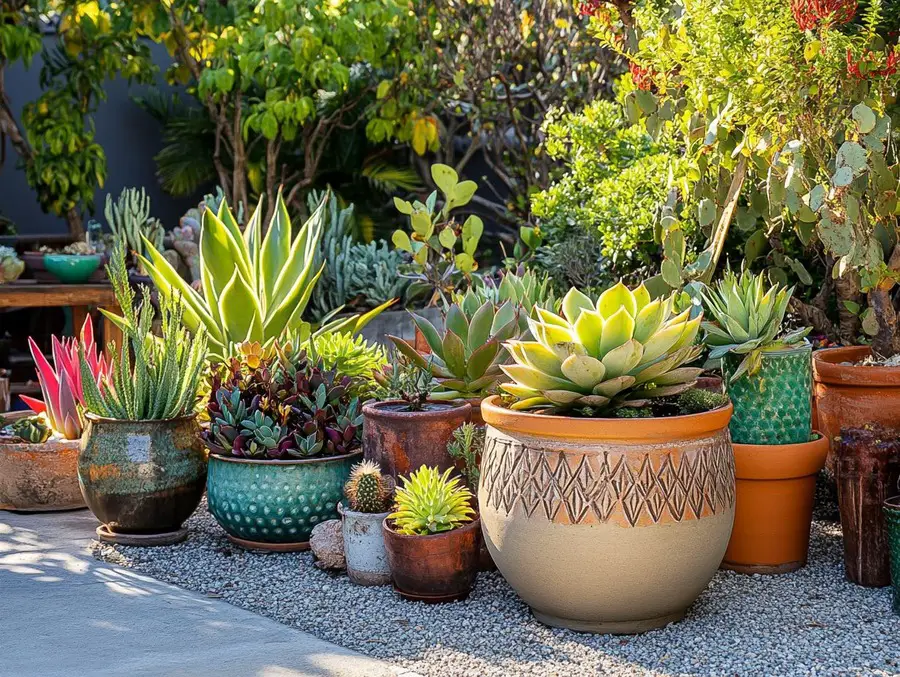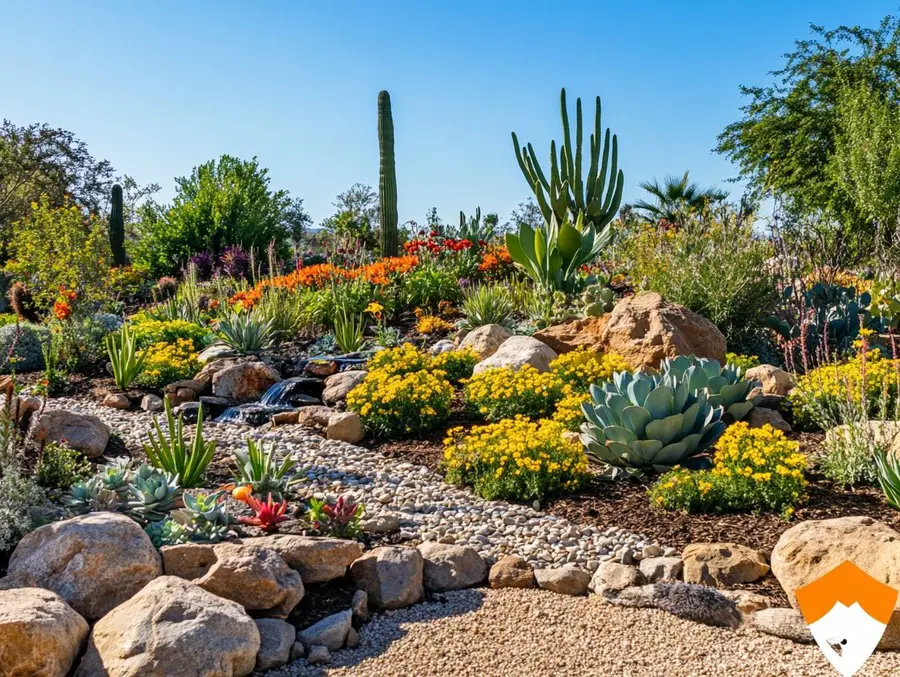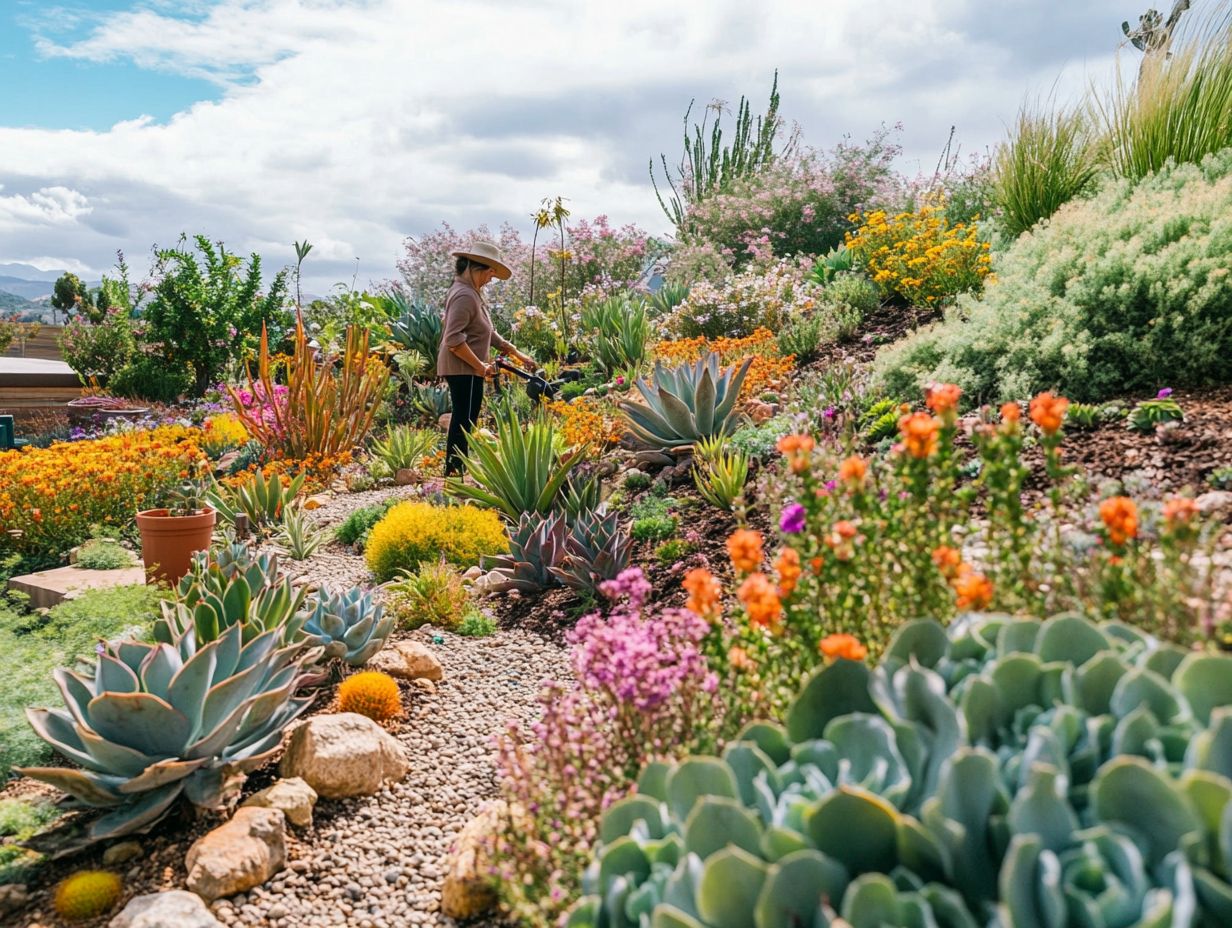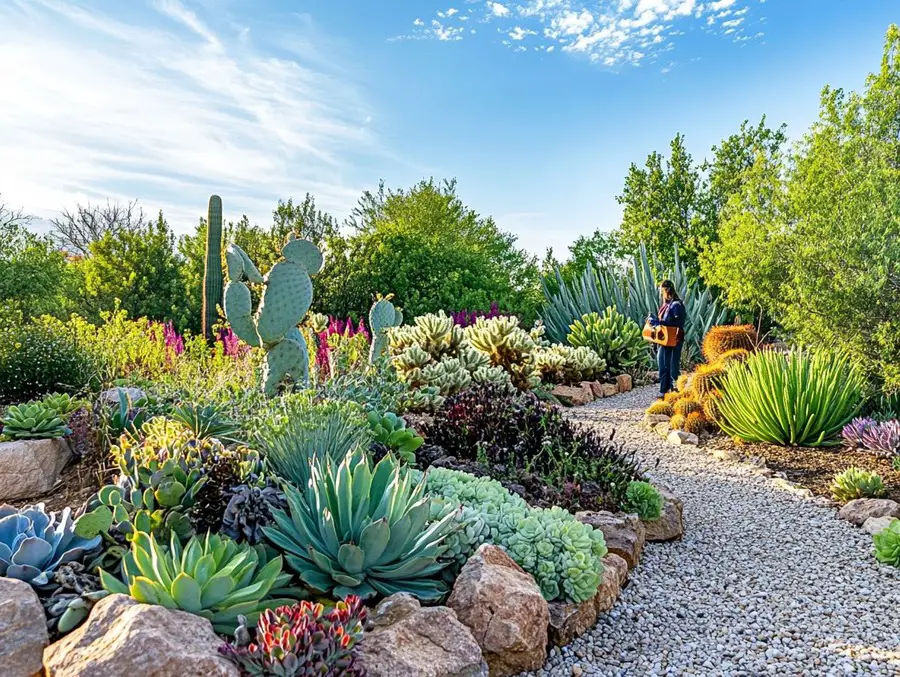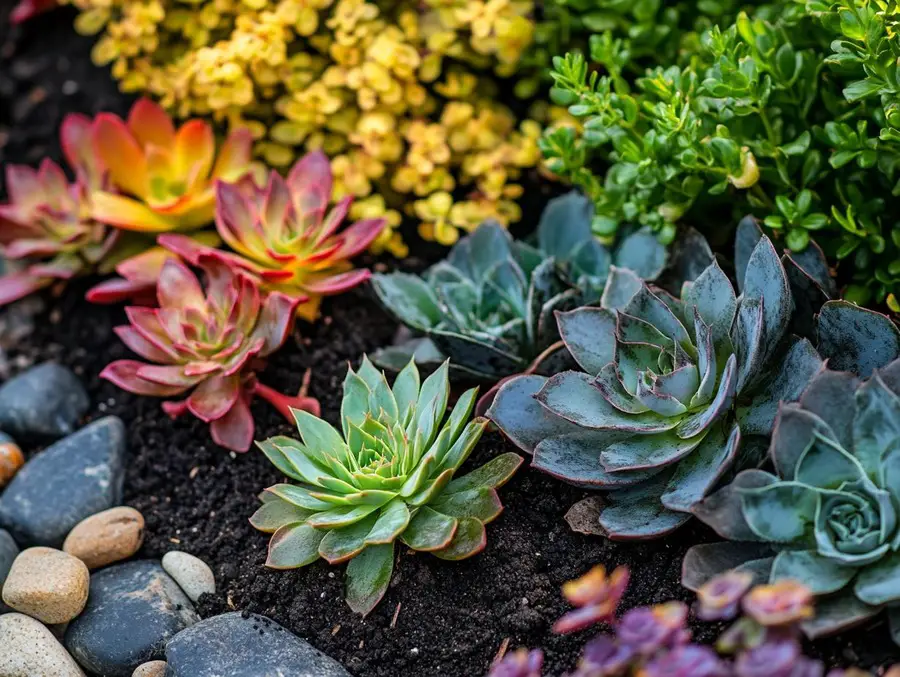We use affiliate links. If you purchase something using one of these links, we may receive compensation or commission.
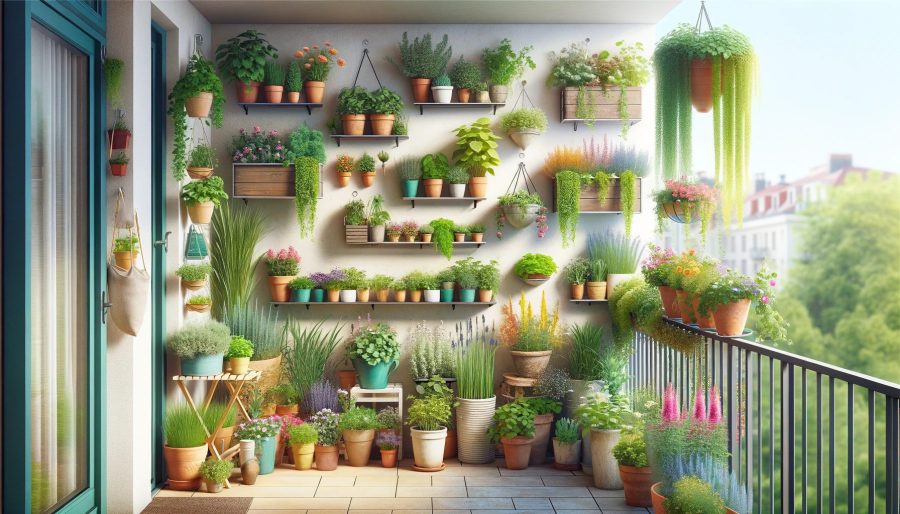
Discover essential tips on how to start a balcony garden and transform your urban space into a lush, green oasis with our easy-to-follow guide.
Starting a Balcony Garden Key Takeaways:
- Starting a Balcony Garden begins with assessing your balcony’s space and sunlight.
- Choose compact, resilient plants suitable for pots and limited space.
- Utilize vertical space with hanging planters and wall-mounted shelves.
- Regularly maintain your garden with proper watering, soil care, and pest control for a flourishing green space.
Are you looking to bring the beauty of nature to your urban living space?
Learning how to start a balcony garden could be the perfect solution.
Whether you have a small balcony or a spacious one, creating a lush and thriving garden is within your reach.
How To Start a Balcony Garden
In this comprehensive guide, we’ll cover everything from assessing your space and sunlight levels to selecting the right plants for your balcony garden.
You’ll learn how to maximize available space, utilize vertical wall space, and maintain your garden for long-term success.
We’ll also explore tips for transitioning houseplants outdoors for the summer, enhancing your garden with balcony furnishings, and recommended plants for balcony gardens.
So, if you’re ready to transform your balcony into a vibrant oasis, keep reading for valuable insights and expert recommendations.
Key Takeaways:
- Assess your balcony’s space and sunlight levels to determine what plants will thrive.
- Choose plants that can survive in limited space and varying weather conditions.
- Maximize space by utilizing vertical wall space and selecting plants with tidy growth habits.
Assess Your Space and Sunlight Levels
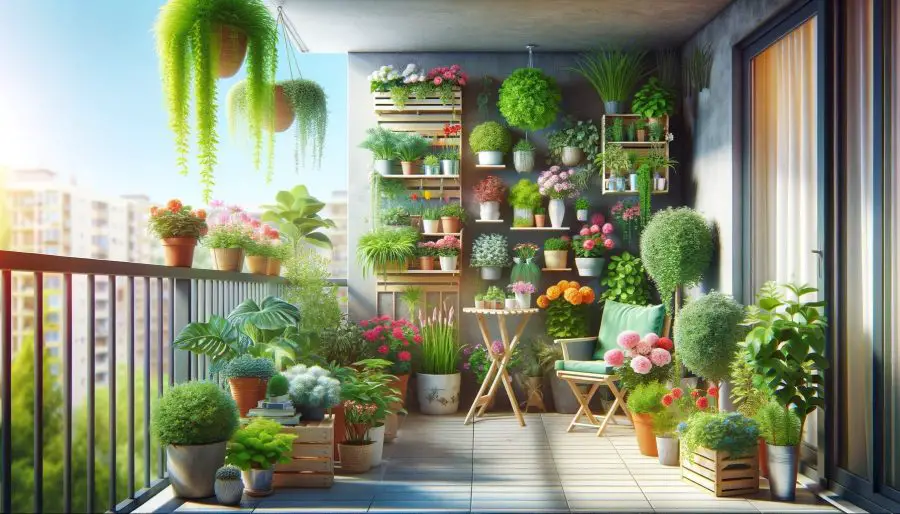
When planning your balcony garden, it’s crucial to assess the available space and sunlight levels to determine the ideal conditions for your plants to thrive.
Factors such as wind exposure and climate conditions also play a significant role in determining the suitability of plant species for your balcony garden.
Assessing the direction and intensity of the wind will help you select plants that can withstand or benefit from such conditions.
Understanding the climate of your region will enable you to choose plants that are well-adapted to the local weather.
Utilizing containers for gardening on balconies is a practical approach to optimize space and manage sunlight exposure.
Container gardening allows for easy mobility, better control over soil conditions, and efficient drainage.
Choosing the right containers can also contribute to creating an aesthetically pleasing and functional garden space.
Choose Plants for Survival
Selecting plants that can adapt and thrive in the limited space of a balcony garden is essential for ensuring their survival and successful growth.
Resilient plants offer the perfect solution for small spaces, as they can withstand various environmental challenges, such as wind, heat, or limited sunlight.
Their adaptability makes them suitable for container gardening, allowing individuals to create green sanctuaries even in urban settings.
Choosing plants that are well-suited to different climate conditions ensures that they can thrive year-round, providing beauty and benefits regardless of seasonal changes.
Selecting the right resilient plants can significantly enhance the appeal and sustainability of a balcony garden.
Select Fruits and Vegetables with Compact Growth Habits
Opt for fruits and vegetables with compact growth habits when planning your balcony garden, as this ensures efficient utilization of space and promotes successful cultivation.
Fruits and vegetables with compact growth habits are ideal choices for balcony gardening as they can thrive in smaller containers, making the most of limited space.
Using herbs with their tidy growth habits not only adds aesthetic appeal to the surroundings but also simplifies the maintenance process.
The efficient use of space enables you to cultivate a diverse range of produce, maximizing your harvest from a confined area.
Their organized growth patterns make it easier to manage and train the plants for better air circulation and sunlight exposure.
Suitable Fruits and Vegetables with Compact Growth Habits
Here is a table showcasing various fruits and vegetables with compact growth habits, ideal for balcony gardening:
| Fruit/Vegetable | Description | Space Required | Sunlight Requirement |
|---|---|---|---|
| Cherry Tomatoes | Small and ideal for hanging baskets or small pots. Require regular watering and full sun. | Small-Medium | Full Sun |
| Bell Peppers | Can be grown in pots; prefer warm conditions and full sun. | Medium | Full Sun |
| Strawberries | Suitable for containers and hanging baskets. Need full sun and well-drained soil. | Small-Medium | Full Sun |
| Radishes | Fast-growing and suitable for small containers. Prefer full sun to partial shade. | Small | Full to Partial Sun |
| Herbs (e.g., Basil, Mint) | Perfect for small pots or window boxes. Require regular watering and partial to full sun. | Small | Partial to Full Sun |
| Carrots | Root vegetables ideal for deep pots. Need full sun and loose, well-drained soil. | Medium | Full Sun |
| Green Onions | Easy to grow in small spaces, even in shallow containers. Prefer full sun. | Small | Full Sun |
| Lettuce | Leafy greens that grow quickly in shallow containers. Prefer full sun to partial shade. | Small | Full to Partial Sun |
This table helps in selecting the right fruits and vegetables for your balcony garden, considering their growth habits, space requirements, and sunlight needs.
Opt for the Right Plants for Pots
Choosing the right plants for pots is crucial for balcony gardening, as it ensures proper soil and space management to support the healthy growth of your chosen plant varieties.
Self-watering pots are great for busy lifestyles and can eliminate over or underwatering.
When selecting plants for your balcony pots, it’s essential to consider the soil requirements of each plant variety.
Some plants thrive in well-draining soil, while others may require a more moisture-retentive mix.
Understanding the specific needs of your plants will help you tailor the soil composition to promote their optimal growth.
The size of the pots plays a significant role in the health and development of your plants.
Larger plants require larger pots to accommodate their root systems and provide sufficient space for growth.
Choosing the correct pot size ensures that the plants have ample room for their roots to spread and access the necessary nutrients.
Effective space utilization is important for balcony gardening.
Selecting plants that complement each other in terms of growth habits and space requirements can help maximize the limited area available.
Use stackable planters to save floor space.
Combining vertical climbers with low-growing plants, for example, can create a visually appealing and space-efficient arrangement.
Maximize Available Space
Maximizing the available space on your balcony is essential for creating a vibrant and efficient garden, especially in small and confined urban environments.
One creative layout design is to utilize vertical space effectively by using hanging planters, and wall shelves or installing a trellis for climbing plants, which not only adds greenery but also maximizes the use of the limited floor area.
Incorporating tiered plant stands or shelves can optimize space, allowing for a variety of plants without overcrowding.
Implementing space-saving techniques such as container gardening and selecting compact or dwarf varieties of plants can help make the most out of the available area, while also providing flexibility for rearrangement to suit different seasons or aesthetics.
Considering climate-adaptive solutions and understanding the sunlight and wind exposure on your balcony can guide the selection of suitable plants, making the space both visually pleasing and thriving with green life.
Utilize Vertical Wall Space for Hardy Plants
Utilizing vertical wall space for hardy plants is a practical approach to maximize the cultivation area in your balcony garden while effectively utilizing available space.
Vertical gardening on balcony walls offers several benefits. It allows you to grow a variety of hardy plants such as succulents, ivy, and ferns which are well-suited to vertical environments.
These plants are generally robust and low-maintenance, making them ideal for vertical gardening.
The vertical orientation helps plants to develop stronger roots and better wind resistance, as they naturally adapt to surviving and thriving in such conditions.
They can also provide a cooling effect on your balcony, especially during hot weather, contributing to climate adaptability.
Maintain Your Balcony Garden
Maintaining your balcony garden is crucial for the long-term health and vitality of your plants, encompassing regular soil care, plant maintenance, and space management.
In terms of soil care, it’s essential to use a high-quality potting mix that provides proper drainage for your plants.
Regularly inspect the soil for moisture levels and nutrient needs, and consider adding organic compost or fertilizer as necessary.
For plant maintenance, pruning, and deadheading are important for promoting healthy growth and flowering.
Keep an eye out for pests and diseases, and address them promptly to prevent spreading.
Efficient space management involves choosing the right plant varieties for your balcony, utilizing hanging baskets or vertical planters, and considering the use of compact or dwarf varieties.
Regular monitoring of sunlight and wind exposure helps to position the plants for optimal growth.
Enhance Your Garden with Balcony Furnishings
Enhance the aesthetic appeal and functionality of your balcony garden by incorporating suitable furnishings that complement the available space and climate conditions.
When considering balcony furnishings, it’s essential to optimize the available space intelligently.
Compact and multipurpose furniture, such as foldable chairs or tables with storage, can help maximize the area without compromising on comfort.
Additionally, choosing weather-resistant materials is crucial for durability and maintenance in outdoor settings.
From sturdy metal to durable synthetic rattan, selecting pieces that can withstand various climate conditions is vital for long-lasting enjoyment.
Transition Houseplants Outdoors for Summer
Transitioning houseplants outdoors for the summer season requires careful consideration of space, climate conditions, and acclimatization to ensure successful adaptation to the external environment.
When moving houseplants outdoors, it’s essential to assess the space they will occupy.
Consider the type of plants and their growth habits. Some plants may require larger areas due to their sprawling nature, while others can thrive in smaller spaces.
Take into account the placement of the plants to ensure they receive adequate sunlight and are sheltered from strong winds.
The climate of the outdoor environment plays a crucial role. Different plants have specific temperature and humidity requirements.
Some may thrive in direct sunlight, while others prefer shaded areas. Research the climate needs of each plant and choose an outdoor location that mimics their ideal conditions.
Acclimatizing houseplants to the outdoor environment is a gradual process.
Start by placing them in a shaded area for a few hours each day, gradually increasing their exposure to sunlight.
This helps prevent shock from sudden changes in light intensity and temperature.
Pay close attention to the moisture levels of the plants during this period, as outdoor conditions may differ from indoor environments.
Top Tips for Balcony Gardening
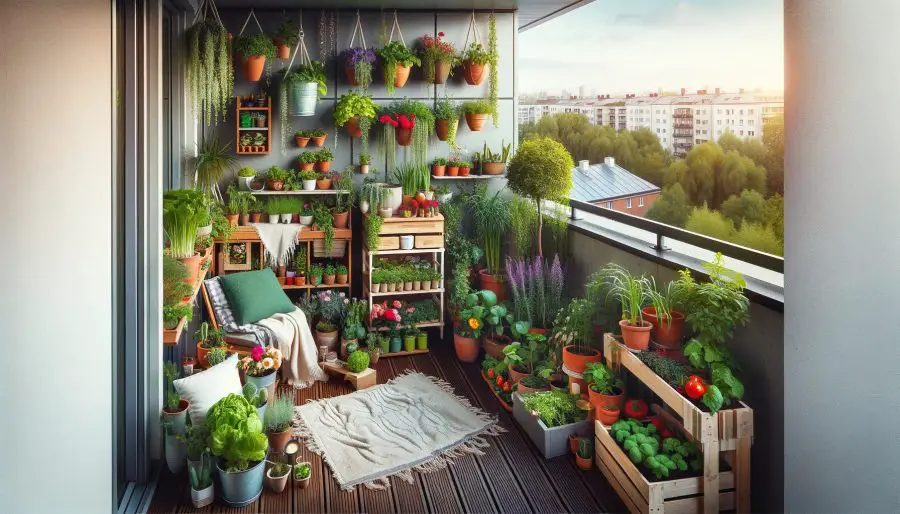
Discover top tips for successful balcony gardening, including effective space utilization, plant selection, climate considerations, and optimizing sunlight exposure for your plants’ health.
In terms of making the most of your balcony space, utilizing vertical space is key.
- Consider hanging baskets, wall-mounted planters, and tiered shelving to maximize the available area.
- Select plants that are suited to the limited space and wind exposure of a balcony, such as herbs, compact vegetables, and trailing flowers.
- Be mindful of your local climate and select plants that thrive in your region’s specific conditions to ensure their long-term health and success.
- It’s also essential to position your plants to capture the sunlight levels they need, so consider using reflective materials or arranging planters strategically to optimize their exposure.
Transforming Your Balcony into a Garden
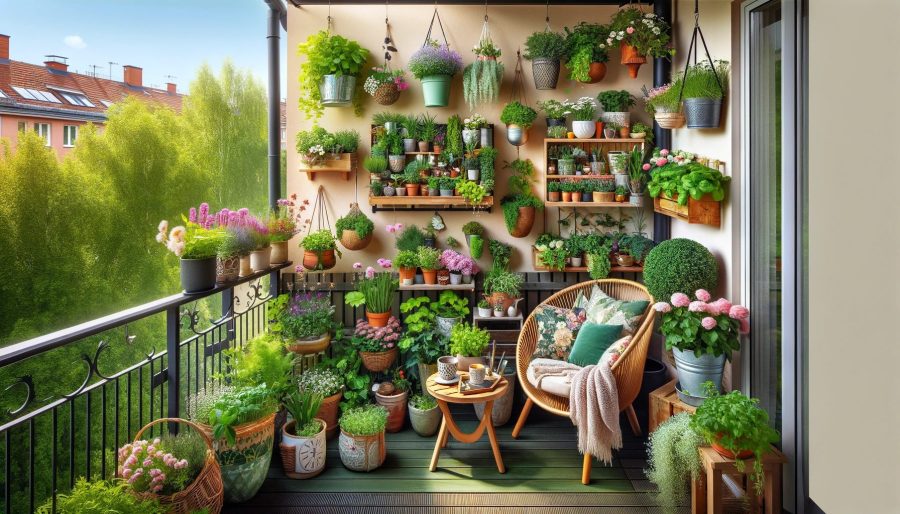
Embark on a transformative journey as you turn your ordinary balcony into a lush and vibrant garden oasis, embracing the beauty of gardening within a confined space.
Your balcony, often an underutilized space, holds tremendous potential for creating a mini-ecosystem that thrives with greenery and blooms.
By maximizing vertical space with hanging planters, utilizing wall-mounted shelves, and selecting climate-adaptable plants, you can create an enchanting green haven.
Consider integrating a cozy seating area amidst the greenery, offering a tranquil retreat right at your doorstep.
With careful planning and nurturing, your once-ordinary balcony can evolve into a lively, transformative garden paradise that adapts harmoniously to your local climate.
Recommended Plants for Balcony Gardens
Explore a curated selection of recommended plants suitable for balcony gardens, encompassing versatile vegetables, aromatic herbs, and space-efficient plant varieties that thrive in diverse climate conditions.
For those with limited space, cherry tomatoes, various lettuce cultivars, and compact pepper plants offer a bountiful harvest without taking up much room.
The native embellishments like lavender, rosemary, and thyme not only provide fragrance but also attract beneficial insects.
Additionally, petunias, marigolds, and portulaca are superb choices for adding splashes of color, while geraniums and fernleaf dill can flourish in both sunny and shaded spots.
Including these plants in your balcony garden can create an inviting and lush green space, complementing your living area beautifully.
Table: Recommended Plants Suitable for Balcony Gardens
Here’s a table featuring recommended plants for balcony gardens, tailored to accommodate versatile vegetables, aromatic herbs, and colorful flowers.
These selections are ideal for diverse climate conditions and space-efficient gardening:
| Plant | Type | Benefits | Ideal Location | Space Requirement |
|---|---|---|---|---|
| Cherry Tomatoes | Vegetable | Produces plentiful fruit in small spaces. | Full sun | Medium |
| Lettuce Cultivars | Vegetable | Varieties suited for compact growth. | Partial to full sun | Small to Medium |
| Compact Pepper Plants | Vegetable | Ideal for containers; productive in small areas. | Full sun | Medium |
| Lavender | Herb | Aromatic and attracts beneficial insects. | Full sun to partial shade | Medium |
| Rosemary | Herb | Hardy, aromatic, and beneficial for insects. | Full sun | Medium |
| Thyme | Herb | Drought-resistant, fragrant, and attracts pollinators. | Full sun to partial shade | Small |
| Petunias | Flower | Adds vibrant color and suitable for pots. | Full sun to partial shade | Small to Medium |
| Marigolds | Flower | Bright, low-maintenance, and attracts pollinators. | Full sun | Small to Medium |
| Portulaca | Flower | Drought-resistant and great for sunny spots. | Full sun | Small |
| Geraniums | Flower | Adapts well to sun and shade; adds color. | Full sun to partial shade | Medium |
| Fernleaf Dill | Herb | Flourishes in sunny and shaded areas; culinary use. | Full sun to partial shade | Small |
This table can help in choosing plants that not only fit the space and sunlight conditions of your balcony but also add beauty, fragrance, and utility.
How To Start a Balcony Garden FAQs
Q. How do I start a balcony garden if I have no gardening experience?
A. Starting a balcony garden is a great option for beginners. Start by choosing low-maintenance plants and reading up on gardening basics, such as watering and sunlight requirements.
Consider starting with herbs or succulents, as they are easy to care for and can thrive in small spaces.
Q. What should I consider before starting a balcony garden?
A. Before starting a balcony garden, consider the amount of sunlight your balcony receives, the size and weight restrictions, and your budget.
Also, think about what kind of plants you would like to grow and their specific care needs.
Q. How much space do I need to start a balcony garden?
A. The amount of space needed for a balcony garden varies depending on the plants you choose.
However, even a small balcony can accommodate a few potted plants. You can also utilize vertical space by hanging plants or using shelves and trellises.
Q. Can I grow vegetables in a balcony garden?
A. Yes, you can grow vegetables in a balcony garden. Choose compact varieties, such as cherry tomatoes, carrots, or peppers, that can grow in smaller spaces.
Make sure to provide enough sunlight and proper care for a successful harvest.
Q. How often should I water my balcony garden?
A. The frequency of watering your balcony garden will depend on the type of plants you have and the climate in your area.
Generally, it is recommended to water your plants 2-3 times a week, but always check the soil moisture before watering to avoid over or under-watering.
Q. What are some common mistakes to avoid when starting a balcony garden?
A. Some common mistakes to avoid when starting a balcony garden include overcrowding plants, not considering sunlight and space restrictions, using the wrong type of soil, and not providing proper drainage.
It is also important to research the specific care needs of your chosen plants to ensure their growth and health.
How To Start a Balcony Garden Conclusion
In conclusion, starting a balcony garden is a rewarding endeavor that brings nature into your urban space.
It’s not only about growing plants but also about creating a personal oasis.
Here, we will summarize key points and offer final thoughts to ensure your balcony garden thrives.
Understanding Your Space
- Remember, assessing your balcony for sunlight and space is crucial. Choose a spot that gets sufficient light and has enough room for your plants to grow.
Right Plant Selection
- Select plants that can adapt to balcony conditions. Consider resilient species that thrive in confined spaces and fluctuating weather.
Effective Space Utilization
- Maximize your balcony space. Use vertical gardening techniques and choose compact plant varieties to create a lush, yet organized, garden.
Ongoing Maintenance
- Regular maintenance is key. Water adequately, provide nutrients, and protect your plants from pests and harsh weather.
Personal Touches
- Finally, add personal touches. Include comfortable seating or decorative elements to make your balcony garden a true extension of your home.
By following these steps, you can successfully transform your balcony into a green haven. It’s a place not just for plants to grow, but also for you to relax and enjoy the beauty of nature.
Learn more in our article: Balcony Gardening: Comprehensive Guide
Related Resources
Explore additional resources and recommended readings on balcony gardening, covering diverse topics such as space optimization, soil management, container gardening, and climate-adaptive plant selection.
Balcony gardening enthusiasts can benefit from a wealth of information available in books, online articles, and gardening forums.
For space optimization, consider exploring vertical gardening techniques, railing planters, and innovative storage solutions.
Understanding soil care is crucial, so delve into guides on composting, organic fertilizers, and pH balancing for container plants.
In terms of container gardening, look for insights on choosing the right pots, drainage tips, and creative repurposing ideas.
A comprehensive understanding of climate-adaptive plant selection involves researching plant hardiness zones, drought-tolerant species, and microclimate effects on balconies.
Recommended Reading
The Edible Balcony by Alex Mitchell
Container Gardening for Beginners
Related Content
Visit my Amazon Influencer Page for videos and gardening products Grow Your Own Garden












